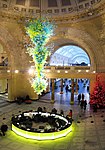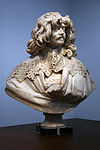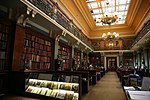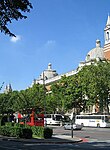Gilbert Collection
2008 disestablishments in EnglandCollections of the Victoria and Albert MuseumDecorative arts museums in EnglandDefunct museums in LondonFormer private collections in the United Kingdom ... and 4 more
Former private collections in the United StatesHardstone carvingLos Angeles County Museum of ArtUse British English from August 2015
The Rosalinde and Arthur Gilbert Collection is a collection of objets d'art formed by the English-born businessman Sir Arthur Gilbert, who made most of his fortune in the property business in California. After initially becoming interested in silver, he assembled a large collection of decorative arts, which he gave the British nation in 1996. It now has a permanent home in the Victoria and Albert Museum in London.
Excerpt from the Wikipedia article Gilbert Collection (License: CC BY-SA 3.0, Authors).Gilbert Collection
Cromwell Road, London Brompton (Royal Borough of Kensington and Chelsea)
Geographical coordinates (GPS) Address Phone number Website Nearby Places Show on map
Geographical coordinates (GPS)
| Latitude | Longitude |
|---|---|
| N 51.496666666667 ° | E -0.17194444444444 ° |
Address
Victoria and Albert Museum (V&A)
Cromwell Road
SW7 2RL London, Brompton (Royal Borough of Kensington and Chelsea)
England, United Kingdom
Open on Google Maps











